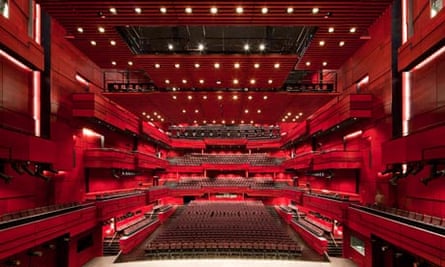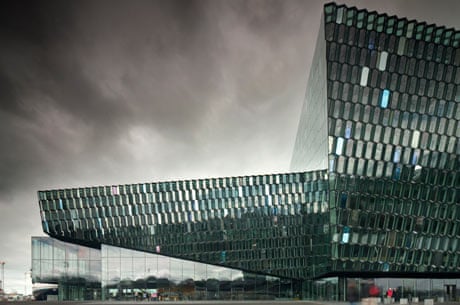There are three reasons to be sceptical about the Harpa concert hall. One is that it is promoted as a "unique" artist-architect collaboration, when such collaborations are quite commonplace and often involve an alliance between architects with too little confidence in their ability to design buildings and an artist with too much. Then it is called "crystalline", a word usually applied by hack practices to glass boxes with a few wonky angles.
And it is in Iceland, the country that went so spectacularly bust that the British government mobilised anti-terrorism laws to freeze its assets. What business have they, three years after leading the world into the abyss, to be opening a $150m (£90m) building, with four halls for music and conferences, the largest of which has 1,800 seats, in a country of 300,000 people, and in a city the size of Ipswich?
The facade of Harpa is the work of an artist, the Icelandic-Danish Olafur Eliasson, who gets more attention and a higher billing than the hall's architects, the 52-year-old practice Henning Larsen Architects. They wear sober suits; Eliasson's leather waistcoat and silver-framed shades suggest creative leadership. His job is to provide that service that would once have been performed by Corinthian columns and statues of buxom nudes: to endow the house of culture with meaning and importance. He has come up with a tilted cliff face made of multiple hexagonal glass tubes, with coloured and mirrored panes inserted here and there. Inside, the hexagons continue, forming a faceted and mirrored ceiling to the foyer.
It is indeed crystalline and, according to the official explanations, inspired by Iceland's volcanic geology. It glitters. It is a bit disco. It has something of Brezhnev-era Soviet architecture, but with bling. It is clearly a work of Iceland's recent past, of the years of magic money rather than of a new austerity. In a town where the standard building type is a two-storey house clad in corrugated steel, it stands out. Only the city's Lutheran parish church, an all-white gothic-deco space rocket, can compete.
Yet something about it arrests scepticism and prevents its dismissal as a banker's bauble. This is partly to do with light, which in Iceland runs from endless translucent days in summer to the brief crawl of the sun above the horizon in winter, with many shades of black, blue and grey in between. Eliasson's crystals filter, reflect and fragment light. They catch it, play with it, animate it and make it mobile. Sunshine lights up the foyers with a refulgence that is almost nuclear. In dim light the building gleams. The hexagonal tubes have glass at the back as well as the front, which gives depth. It means that light inhabits the facade rather than just bouncing off it.
It also changes in response to the movements of the viewer. Eliasson is best known in Britain for his Weather Project of 2003, in the Turbine Hall of Tate Modern, in which two million visitors came to lie on the floor and contemplate an artificial sun alongside their own reflections in a reflective ceiling. At Harpa, as with the Weather Project, the idea is that people are participants as well as spectators.
"I am interested in the way things look different from one angle or another," says Eliasson, and if a building responds to the movement of people, they become "co-producers". It "becomes generous. If I move and it changes, I feel that the building and the site respect me." If several people are doing this at once, as at the Weather Project, "there is a feeling of community – people feel connected – successful public space supports the idea of connectivity".
That he, an artist, has to be brought in to provide these things suggests a failure by the architects, and he agrees that "the brutality of clients has created more compromises, which some architects have failed to navigate. With art you never have a client who says things like: 'Can you change that colour into green?', because then they don't have a work of art any more." So artists can insist on what is important. He says, however, that "there is not a macho competition" between artists and architects, "but, without becoming the same, a merging and blurring".
Eliasson's words about "co-producers" might sound theoretical, but they describe what happens at Harpa. The big glass wall is active and interactive, made up of the movements of people inside and outside the building, who then take more notice of one another. It is this that sets Harpa, which is in fact a glass box with wonky angles, apart from many other examples of the genre.

Of course sound, not light, is the main business of a concert hall, and the world is littered with auditoria where acoustics have been sacrificed to spectacle. At Harpa the two are kept apart. If the facade is Eliasson's, the halls are the domain of acoustic consultants Artec, who have guided some of the most successful modern auditoria in the world, and at Harpa have produced a clarity of acoustic that has reportedly moved some performers to tears of joy.
Between Eliasson's light and Artec's sound comes the architecture of Henning Larsen Architects, and a core of dark concrete the colour of Iceland's lava fields, that acts as a foil for one and a container for the other. This stands inside the glass box, forming the inner walls, balconies and stairs of the foyer. It is an admirably self-effacing role that the architects have chosen, and a collaborative one: Eliasson's art was not simply attached to their frame, but created by artist and architect working together. The result is not a perfect integration of looking and hearing but a happy coexistence.
Harpa belongs to a new genre of building, the boomtime icons that arrived late at the party. Its conception was in 2004, in Iceland's age of financial hallucination, when consortia of banks, architects and others were invited to bid for the privilege of building the home, long wished-for in this music-loving country, of concerts and opera. The winning group was led by Landsbanki, which would be a leading player in Iceland's Gatsby moment.
When Landsbanki crashed many, perhaps most, Icelanders took the obvious view, which was that with people losing homes and jobs an expensive, oversized concert hall was not their priority. But its structure was four storeys out of the ground and, faced with the alternative of abandoning it as an instant ruin and all-too-eloquent symbol of failure, the government pressed on. They took over the project and "with the help of very clever financing", as one of those responsible for running the place puts it, they "made it light for the taxpayers". Now the official blurb declares Harpa "a symbol of Iceland's renewed dynamism".
It still looks misplaced, like a 64-inch TV inside a caravan, but the Harpa management say that the "size turns out to be just right. It fills out just about every event." They also say they like the fact that the bank is no longer calling the shots. It means they can make the place more popular and less corporate. It will take time to find out if Harpa can truly sustain itself, and no one there claims that if they were starting over again they would do it in the same way. But there might be times when a huge TV is a good investment in cheering up, and the same goes for Eliasson's amazing glass.

Comments (…)
Sign in or create your Guardian account to join the discussion